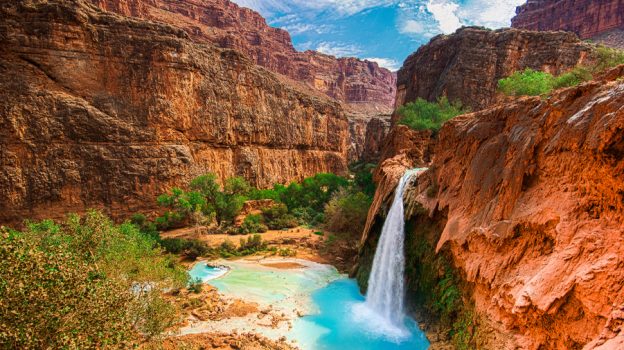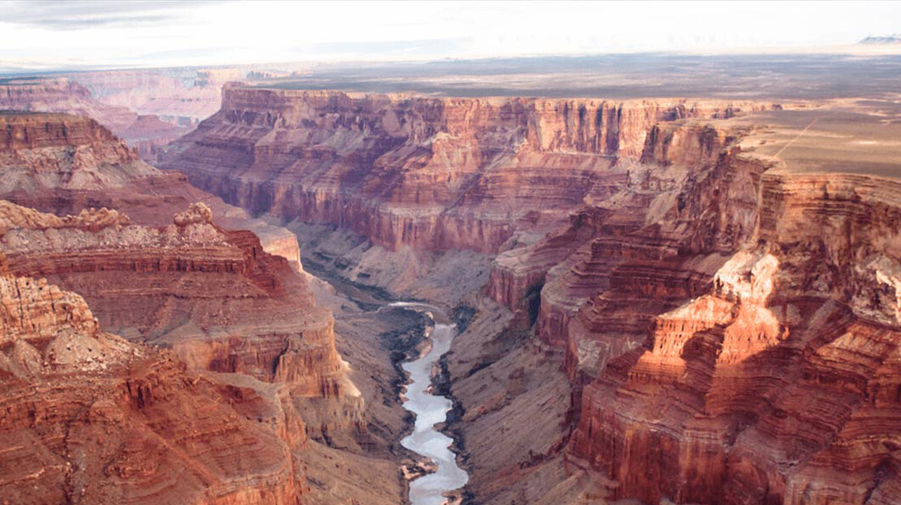
In 2021, over 4.5 million tourists visited the Grand Canyon, cementing the park’s status as one of the most popular natural tourist attractions in the world. Yet, just 35 miles west of Grand Canyon Village, lies a quiet slice of nature many believe to be among the most beautiful areas in the world. While not as famous as the Seventh Natural Wonder of the World, it may be just as extraordinary, and growing in popularity. Even if it is not easy to get to.
Havasu (Cataract) Canyon is considered a true paradise on Earth, with four immaculate waterfalls, crystal clear water, travertine columns and breathtaking views in every direction. It is one of the most photographed places in the world. It is also the home of the Havasupai Indian Tribe, one of eleven Native American tribes that are traditionally affiliated with the Grand Canyon National Park and the only Native American tribe that still lives below the rim of the Grand Canyon.
Who are the Havasupai?
The Havasupai Tribe has called the Grand Canyon home for centuries, dating back as far as 1300 AD. Tribal members call themselves the Havasu Baaja, or “the People of the Blue Green Waters” and have long been the guardians of the Grand Canyon.
The Havasupai currently live in Supai Village, the most remote community in the lower 48 states, 2,000 feet below the Grand Canyon’s rim. Supai is eight miles from the nearest road and has no vehicles of any kind in the community. It is accessible only by helicopter, on foot or by mule. Yes, mule. In fact, Supai is the only place in the United States where the mail is still delivered by mule train.
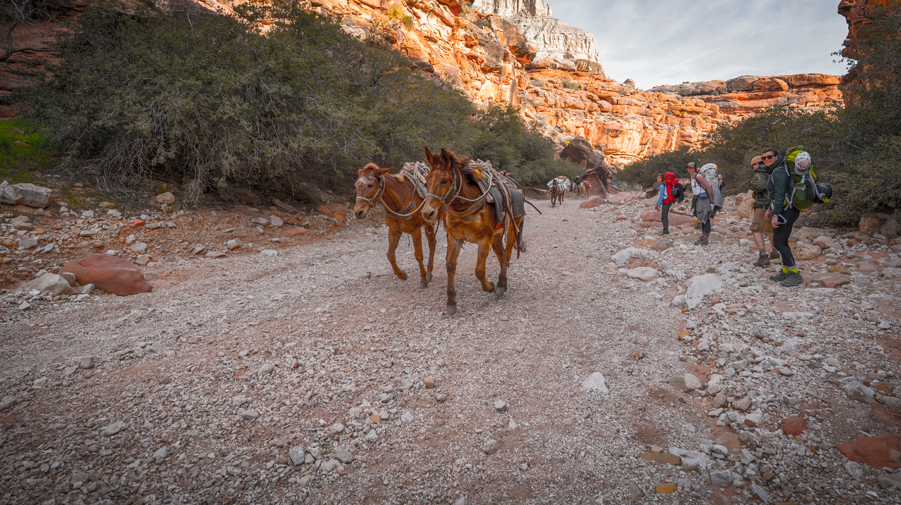
For most of their existence, the Havasupai people were spread out far along the Grand Canyon South Rim, hunting for food on the plateau shelf while also being skilled in agriculture and growing crops along the riparian banks in the canyon itself. Where they live now in Supai village was considered their summer home. However in 1919, the US federal government created the Grand Canyon National Park and relocated the tribe to a reservation of just 518 acres – five miles wide and twelve miles long.
Havasupai translates to “people of the blue green water” in the tribe’s native language
In the 1970’s Congress restored much of their original land to the Havasupai – 188,077 acres in all – which makes up their reservation today.
The land on the reservation is one of the most extraordinary natural wonders in the world. Largely a plateau – like much of the Grand Canyon near the Colorado river – the land is home to hidden, awe-inspiring canyons, gentle rolling slopes, and Kaibab Limestone. Some of the more well-known and highly photographed geographic features include The Great Thumb, Long Mesa, and Tenderfoot Mesa, along the Coconino Plateau at the south end of the reservation.
The Havasupai still remained largely isolated from the outside world, but now rely on tourism for their economy and well being. Animals are often seen freely roaming the area, there is no Wi-fi or broadband, and there is limited basic housing needs like plumbing and electricity. The last known population was 639 members at an average age of 25.
100% of their population, all 629 people, still speak their native Yuman language.
What makes Havasu Canyon so special?
It is nearly impossible to describe the natural wonder of the Havasupai reservation. Even pictures and videos do not do it justice, you have to see it yourself, with your own eyes.
Havasu Canyon is home to dozens of natural water pools, countless cottonwood trees, flowers and plant life of seemingly every variety – not to mention natural wildlife. But what makes this place so special, and keeps tourists from the world over coming back year after year, are the most magnificent waterfalls known in North America.
Once you leave Supai Village, the first waterfall you encounter is Navajo Falls, about a half mile from the campground. It is roughly 70 feet high, however it used to be called “50 Foot Falls” prior to a massive flash flood about 80 years ago that buried the waterfall in sediment. In August 2008 there was another incredible flash flood which reshaped the entire Havasu Canyon. The flood was so violent it carved out entirely new waterways and created two new waterfalls, including the “new” Navajo Falls upstream where 50 Foot Falls once was,
Little Navajo Falls is the other waterfall created by the August 2008 flood. It lies just downstream of Navajo Falls, and is about 30 feet high. It plunges into a gorgeous little swimming hole that is becoming more and more popular among the more adventurous tourists.
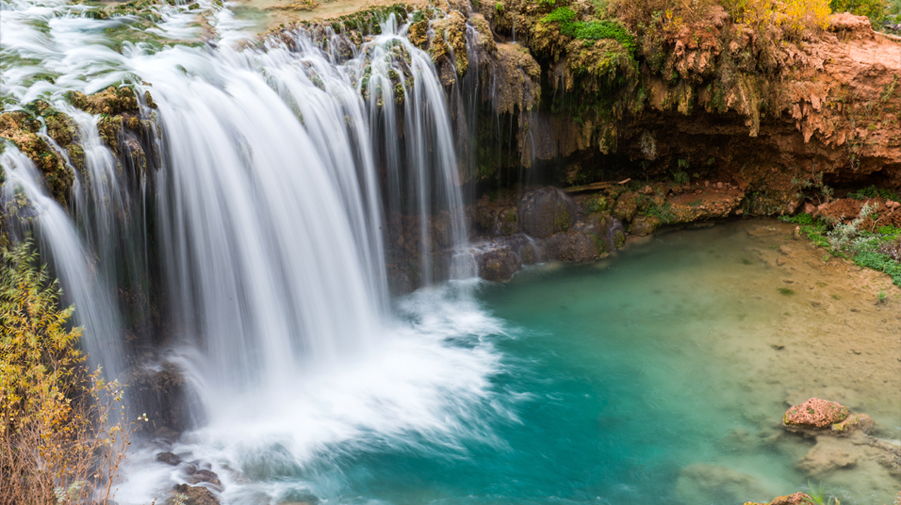
The most recognizable waterfall is Havasu Falls, located roughly half a mile past Navajo Falls. This waterfall is around 90 feet tall and plunges into a beachfront swimming hole surrounded by cottonwood trees that is one of the most photographed and popular in all of the Southwest.
Just like Navajo and Little Navajo Falls, Havasu Falls was largely formed thanks to an incredibly violent and powerful flash flood over a century ago. In those days, the flowing water fell over a 200 foot cliff that was spread out fairly wide. However the flash flood destroyed most of that cliff, and channeled the water into a much more narrow waterfall that to this day is among the most beautiful and awe-inspiring anywhere in North America.
About a mile past Havasu Falls is perhaps the most awe-inspiring, yet dangerous, waterfall – Mooney Falls. The trail leading down to it is very narrow, and can be slippery or have several obstructions. To get to the bottom of the 200 foot waterfall you will literally have to scale a cliff using repelling equipment or chains, and make your way through a hazardous tunnel cut through the side of the canyon wall by miners over 120 years ago, followed by slowly descending a ladder that looks like it’s been there for decades.
The Havasupai tribe refers to this waterfall as the “Mother of the Waters,” and they consider it their most sacred waterfall. It is also the most tragic. Mooney Falls is named after American prospector Daniel Mooney fell to his death in 1880 trying to lower himself down to the bottom of the falls shortly after discovering it. Almost exactly 100 years later, after the federal government seized the waterfall from the Havasupai for Grand Canyon National Park, a private company attempted to build a hydro-electric plant on it. But before the plant could be constructed, a flash flood destroyed the plant and machinery, resulting in a total loss and bankruptcy for the company. Congress would return the waterfall to the Havasupai not long after.
“On travel sites and message boards, the words “bucket list” often appear in people’s reviews of the falls.” – Arizona Republic
But once you make it down there is an extraordinary 15 foot deep swimming hole. Many tourists consider this watering hole the highlight of their trip (no doubt in part due to the adventure in getting down to it). This popularity naturally can lead to some overcrowding during peak times. Due to it being mostly shaded, the waters can also feel a little colder than the other swimming holes. So, as always, come prepared.
Finally, last but not least, there is Beaver Falls, easily the most unique waterfall of the canyon. Unlike the others, you do not hear loud, crashing noises emanating from water falling hundreds of feet into shallow pools. Instead, there are several small cascades gently rolling down Havasu Creek into crystal blue and turquoise waters, colors caused by the natural minerals dissolved in the water.
Beaver Falls is – of course – difficult to get to, but also well worth the trek. Once you leave Mooney Falls, you continue along the trail hugging the western canyon wall. On this trail you’ll see more ladders leading up into the cliffs. But as your guide will tell you, don’t climb them out of respect for the Havasupai, as they lead to a historic burial site.
Located a full three miles from Havasu Canyon, you will need comfortable hiking shoes, sunscreen and plenty of water to make the journey. You’ll also find three creek crossings as you head to Beaver Falls, so be sure to also bring along water shoes.
If you are feeling particularly vigorous and adventurous you may continue the hike all the way to the Colorado River, a full eight miles from the campsite. However, this is not recommended as the route is unmarked and outside of the reservation. So no one will be available to help you should you get hurt or get lost. A flash flood would almost certainly be deadly. So best to stay with your group, and within the Havasupai reservation.
Getting started
The best way to reach the Havasupai tribe is by heading down the historic US Route 66, onto Indian Route 18, a somewhat bumpy, 64 mile road to Hualapai Hilltop. From the Hilltop parking lot there is an eight mile trail to Supai Village (there are no roads leading to the village) and roughly two to three more miles to camping and the waterfalls (depending on how many you wish to see).
The first couple miles from Hualapai Hilltop, marching down the Havasu Falls Trail into the bottom of the Grand Canyon, is fairly difficult. There are switchbacks that change in elevation by 1,800 feet. However the next six miles to Supai are relatively flat. The entire eight mile trail to the village may be traveled either on foot or horse, and pack mules may be available as well.
If that much physical activity isn’t for you, there is helicopter travel available through Airwest Helicopters. There are no reservations allowed for the helicopter, it is first come first served prior to 10am, and Havasupai tribal members have priority. Cost is around $85 per person. But if you manage to secure a seat on the helicopter, it takes just 15 minutes to get to Supai Village.
The Havasupai Falls Hike may be the most breathtaking hike in the Southwest
Otherwise, it is highly recommended that you prepare yourself for a long and arduous hike. Be smart, try not to hike midday in the hot summer months. Don’t try hiking it at night where you could easily get lost without anyone around to help find you.
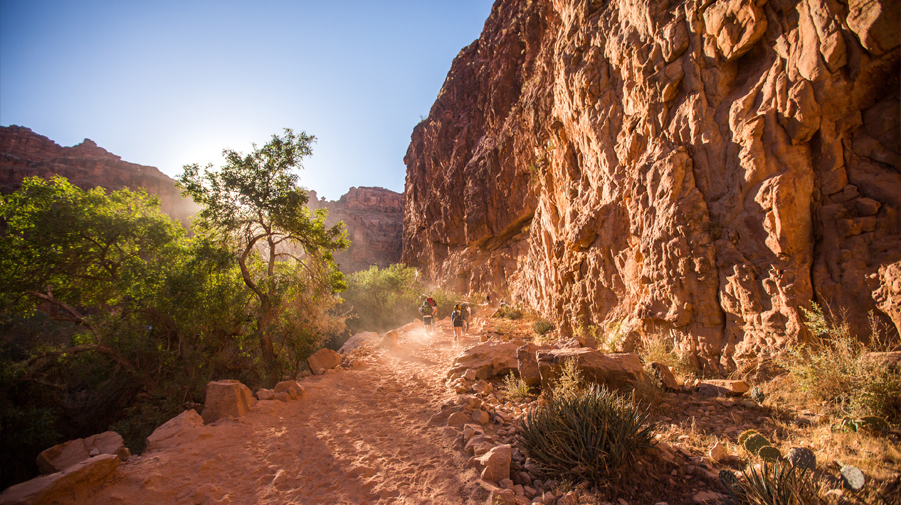
Hydrate, hydrate, hydrate. There are no drinking water stations along the way. So be sure to bring a minimum of one or two gallons of water – more if temperatures reach triple digits. Try hiking in the early morning when temperatures are lower, ideally starting around sunrise. Shade is your friend. If you find yourself feeling exhausted, and see a nice shaded area – use it, and take a break.
Know your limits. You do not have to be in peak physical condition to complete the adventure, but if you are injured or recovering from injury it may be best to postpone your trip until you are back to 100%. If you are overweight, be sure to pace yourself and take breaks if you need them.
And of course, be mindful of other guests, particularly during “peak” times – mid-morning on weekends – and let others that are moving faster than you pass through. If you have a fear of heights, try to avoid these peak times and talk to your guide before descending down the cliffs.
What you need before you visit
First and foremost, all visitors to the Havasupai reservation must obtain a permit before entering. To prevent overcrowding, the Havasupai limit the number of daily permits issued.
Secondly, you’ll need to decide on your accommodations. Many tourists prefer to stay at the Havasupai Lodge, aka “the Lodge” in Supai Village. The lodge has all the amenities you will find in a contemporary hotel room, including Wi-Fi. However, there are only 24 rooms available and they tend to book very quickly.
At last check, Lodge rates run between $145 to $440 per night for a two or four-person room, plus a $110 entrance and environmental fee per person. These fees also include your permits and taxes. All visits require at least a one-night reservation. Keep in mind that tourism to the Havasupai reservation has been suspended since March of 2020 due to the Covid-19 pandemic. All fees and rates may change once tourism is allowed to resume.
For those visitors who would rather stay on the campgrounds, they are located on both sides of Havasu Creek between Havasu Falls and Mooney Falls. There are no assigned campsites, it is simply first come, first serve as far as finding your camping spot within the designated areas. Camping anywhere else besides the designated campgrounds is strictly prohibited.
For campers, be sure to bring the usual camping necessities: a tent, sleeping bag, pillow, blankets, toilet paper and other supplies. You may bring a stove. However, as with any outdoor camping, be sure that any food you bring is secure, otherwise you may invite some unwanted wildlife onto your campsite.
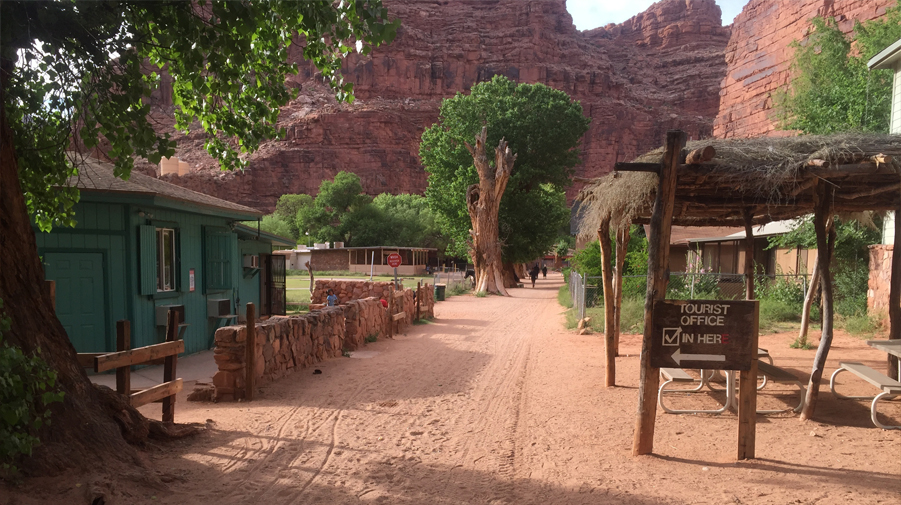
There is drinking water available in the village and at the campsites or you can bring a strong filtration system and drink from the river. Composting toilets are also available.
For visitors who don’t particularly care for “roughing it”, there is a cafe near the Lodge that is excellent, and a village store that carries basic necessities and some souvenir items. Keep in mind that these businesses have been essentially shuttered since the beginning of the Covid-19 pandemic over two years ago, so supplies may be limited and staffing may be short. So please be kind to those trying to help you, and be patient.
Overall, there are enough campsites to host as many as 300 campers per night, and cost $25 (plus 10% tax) per person, per night (at last check). All campground reservations are for exactly three nights and four days. If you are looking for a longer or shorter stay, make your reservation at the Lodge instead. All payments are due at the time of booking, and only one credit card is allowed per group. Payments are non-refundable and permit reservations are non-transferable.
“(Havasupai Lodge) has fairly spartan accommodations—each room has two double beds and a bathroom—but you won’t mind much when you see the natural beauty surrounding you,” – Fodor’s
Prior to the Covid-19 pandemic, all reservations for the campground had to be made online at HavasupaiReservations.com, while all reservations to the Lodge had to be made by phone ((928) 448-2111). Again, once the Havasupai reservation re-opens to tourists, PLEASE be patient and understanding, as Tribal employees have not been working with visitors for over two years, since the very beginning of the pandemic. Many tribal operators and employees will be new or in training. If no one answers your call, just keep trying. The same goes for emails and other communications.
As for things to bring on your trip, most are common sense. Bring a hat, sunscreen and snacks (but please keep the litter with you until it can be disposed of). A first aid kit is highly recommended, as are things such as a flashlight, whistle and compass in case you get lost or need help. Above all else – HYDRATE. Bring a minimum of one gallon of water, but the more water the better.
For your visit to the famous swimming holes, bring a bathing suit, water shoes and a towel. Remember you are allowed to bring a camera to photograph the waterfalls and canyons. But out of respect for local customs, please refrain from photographing Havasupai Tribal members or structures themselves.
When to go and for how long
Havasu Canyon is open to visitors all year round, however, peak tourist season is May through September. Weekends are often much busier, so it is recommended that you visit during the weekday if possible.
Monsoon season in Arizona begins in mid-July and can go as long as mid-September, when flash flood dangers are at their highest. However, peak tourism season tends to have the most sunshine and warmest weather for swimming. Spring and Fall months still have warm air temperatures but might have colder water to swim in.
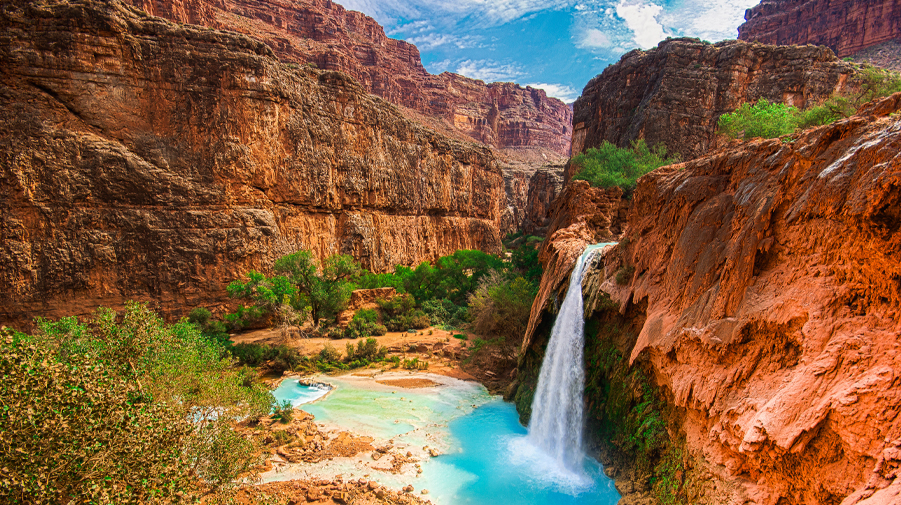
Winter months (December through February) can sometimes be very frigid, and has been known to see severe hailstorms and even blizzards. Seeing the waterfalls during the winter months can be quite extraordinary, but only adventurous tourists willing to brave potential ice and snow should even consider going during this time – even if you are staying at the Lodge.
The average tourist stays between two and three nights. This gives them enough time to visit all the waterfalls and natural beauty of the area without feeling rushed. Also, one to two days worth of food, water and supplies is about the most many tourists are willing to lug along with them for this adventure.
Be prepared
If you take away only one thing from this article, let it be this: While visiting the Havasupai reservation is an extraordinary experience – it is not for the faint of heart. And it can be dangerous for anyone who has not both physically and mentally prepared themselves prior to arrival.
As noted previously, the trek to the village is long and grueling. Some parts of the hike can be treacherous, and can result in injury if you are wearing inappropriate footwear (something without a strong grip), are not paying attention to where you are going, or do not bring enough water.
Make sure you bring plenty of water, and take a rest in the shade if you start to feel symptoms of heat stroke or exhaustion
Again, do not hike at night and avoid hiking midday when temperatures exceed triple digits. Sometimes temperatures can reach as high as 115 degrees, and this summer could see more heat records broken. Always hydrate, and be aware and seek help if you are showing signs of dehydration (headache, dizziness, confusion). Of course, NEVER hike alone. Always make sure someone knows where you are at all times.
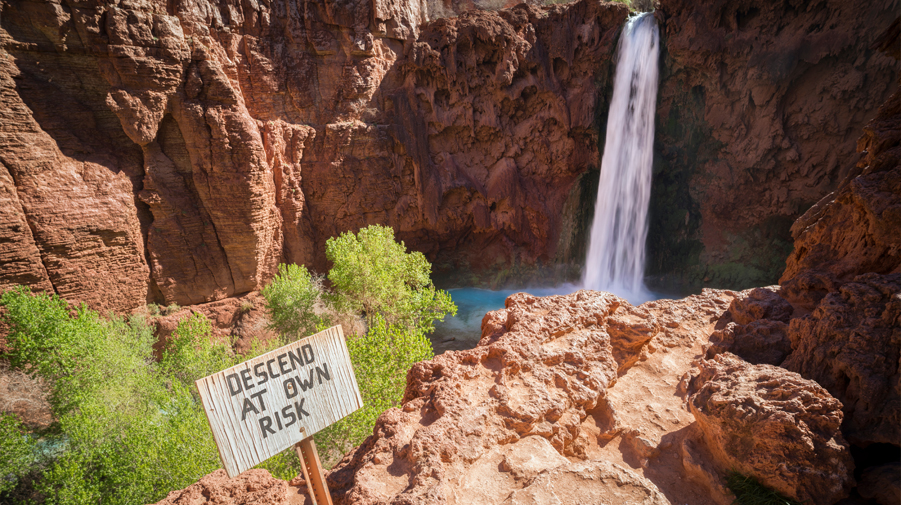
As noted previously, there have been numerous, dangerous flash floods that have reshaped the landscape over the decades. Should you find yourself in the middle of a flood, get to high ground immediately and wait for help.
Once you enter the canyon, there is no cellular service. There is no emergency assistance if you are injured. In fact, if you are unable to walk due to your injuries it could take several hours to get you out of the canyon and to a medical facility. On top of that, you will be responsible for the full cost of any rescue efforts.
Please respect the land and those who protect it
The Havasupai tribe generously opens their homeland to visitors from all over the world, allowing them to experience the area’s extraordinary beauty and spirituality. But it is very important to keep in mind that Tribal members consider the land to be sacred, and that anyone visiting should be mindful and respectful of the land and those that reside there.
The land is fragile and easily desecrated, even by those who don’t mean to. Do not leave any trash, stay on the trails and do not attempt to take stones, plants, wood or other natural materials with you as a souvenir. And of course, any vandalism, such as carvings or drawings, is strictly prohibited and could result in arrest.

The Havasupai tribe considers themselves the guardians of their land, and view all the natural wonders as sacred to them. The tribe also adheres to the culture, traditions and heritage that have guided them for centuries. Considering the Havasupai are your gracious hosts while you are visiting, their costumes and beliefs should be respected. That means leaving any alcohol or drugs behind, no loud or disruptive behavior – which includes playing loud music – and no profanity. Also, the use of drones are prohibited, as are firearms of any kind. All luggage and vehicles are subject to search for prohibited items when entering the Havasupai Reservation.
To the Havasupai, the water is sacred, flowing not only across the land but through each tribal member
While the actual Tribal members are friendly, it is important to keep in mind that traditions dictate that no photographs of the Havasupai people or Havasupai property, including the buildings in Supai, are allowed at any time. Please be mindful of this, and respect their wishes.
This is the home of the Havasupai, their sacred land, which they are welcoming you to. So by all means have fun, enjoy the trails and waterfalls, and take lots of pictures of their incredible natural beauty. The tribe simply asks that you respect their land and their culture while you do so.
NOTE: All Havasupai tourism has been suspended since March 2020. It is not currently known when tourism will resume, however it is possible limited tourism will resume on June 1, 2022.

